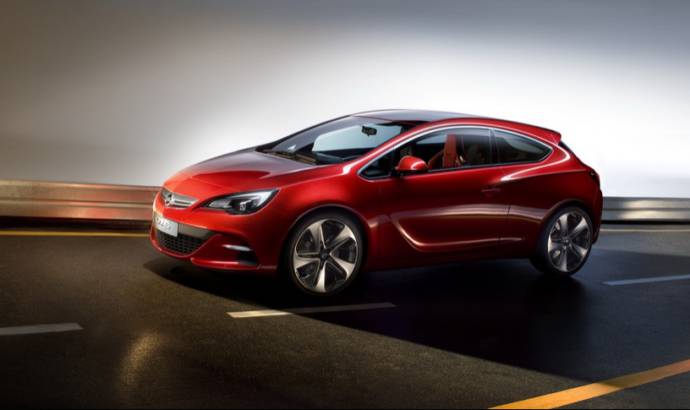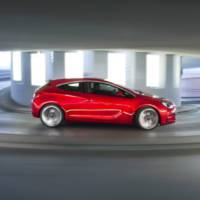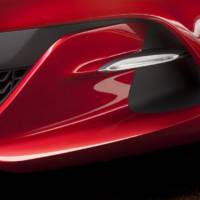Opel / Vauxhall have released plenty of photos and additional details regarding the GTC Paris Concept which will be shown at the Paris Motor Show starting from next week.
The Opel GTC Paris is basically a preview of the 3-door version Astra GTC which will enter the market in 2011, and the car’s sporty features like the aggressive looking front bumper and the massive alloys indicate we also might be seeing an OPC version as well.
The automaker has also announced that the engine powering the Opel GTC Paris is a twin-scroll 4-cylinder 2.0-litre Turbo that uses a 6-speed manual gearbox, and which delivers 290 HP (213 kW) to the front wheels.
The Opel GTC Paris also features a limited slip differential plus a Start/Stop system that helps keep emission levels low.
Opel press release :
- Sculptural Artistry: Dramatic proportions and dynamic sweeping lines
- German Engineering: 213 kW/290 hp 2.0 Turbo DI; FlexRide adaptive suspension
- Affordable: The achievable dream car
- Momentum: Concept showcases energized brand
Paris/Rüsselsheim. The GTC Paris concept car embodies the passionate
side of Opel: Its role is to show how Opel can “dial up” the brand’s
now established design direction by creating a very sporty and emotional
interpretation.
The GTC Paris is designed to be artistically sculpted using sweeping
dynamic lines. At the same time, it is engineered with German precision
and energized with technical innovation, like a 2.0 liter Turbo gasoline
engine with direct injection, a new execution of the fully adaptive
FlexRide suspension and an limited slip differential in the front.
This three-door sporty hatch is pure but sporty, simple but
expressive and at the same time bold and iconic. Keeping in line with
Opel’s DNA, it is an achievable dream car, conceived to showcase an
energized brand. This energy is also conveyed by the vibrant and
expressive Liquid Metal Red exterior color.
Coming close on the heels of the new generation Astra Sports Tourer
which will also debut at the Paris motor show, the GTC Paris is how Opel
envisions the next logical step of a newly shaped line-up.
Exterior design: Muscular lines like tendons on a sprinter
At 4.46 meters, the GTC Paris is the ideal size for a compact, sporty
car, which still offers room for five. In profile, the designers have
maximized drama by limiting the amount of lines in the GTC Paris. Three
strong lines create tension and provide a sculpted shape. The Opel
signature blade is introduced in the same direction as first seen in the
Insignia — a fine, crisp line that sweeps upward from the rocker at
the beginning of the front door. A second line encapsulates the door
handle and sweeps to the rear, emphasizing the vehicle’s dramatic stance
by spreading the surfaces to a fine undercut and a broad shoulder. The
third line following the silhouette of the roof is finished in finely
brushed aluminum accentuating the window graphic, which guides the eye
to the sharply accented integrated spoiler.
The shoulder section is the most dramatic area of the Opel GTC Paris.
The broadest point pulls down to a wide athletic “bulldog stance,”
giving the car a very purposeful road presence. The line from the
C-pillar slides into the tail and curls around into the rear spoiler,
which is ingeniously integrated into the continuing roof line.
The clean frontal styling features Opel’s typical centerline crease.
It is further accented by intense, very slim eagle-eye shaped headlamps
acting as parenthesis between the refined chrome emblem bar and the
dramatic low trapezoidal grill which hints at its sporty character. Opel
typical wing-shaped signature LED daytime running lights get a new
twist with finely sculptured chrome jewels that are seen easily behind
clear glass. The trapezoidal grille is recognizably Opel, but separate
from the chrome bar and placed lower, for a race track feel.
The wide stance is accentuated in the rear, where the proportion of
the vehicle is most imposing due to the powerful shoulder design. This
is further enhanced with the LED taillights and one long stretched
“wing” motif, which make the new Opel vehicles distinguishable at night.
The aerodynamics of the dynamic 21-inch wheels is optimized with carbon-fiber inserts which enclose the center caps.
Purposeful driver’s cockpit
Echoing the flowing, sculpted forms of the bodywork, the hallmarks of
the GTC Paris interior are sweeping lines and shapes as well as the
bold use of fabric. The interior is driver-focused, with a
positive/negative use of color: Whereas the driver’s seat is red with
black trim, all other components in the interior are outfitted in a
charcoal black with red stitching. The car’s inspiration, a quote from
Richard Bach’s novel, Jonathon Livingstone Seagull is laser-etched in calligraphy script into the seat … “and the speed was pure beauty.”
Sporty, bucket front seats have been specially designed for the GTC
Paris. Their aggressively shaped contours and graphics perfectly
compliment the overall dynamic spirit of the car are outlined in
titanium and filled in with black netting, repeating a design cue seen
on the carbon fiber inserts on the wheels.
The small black leather racing steering wheel features metal inserts.
On the dashboard, the interior continues Opel’s recurring “wing” and
“blade” motifs. In this execution, the blade theme is expressed in
details like the shape of the polished chrome door grab handles and the
trim for gearshift molding. The wing design cue is immediately evident
in the warm, inviting wraparound instrument panel that embraces front
seat occupants. It arcs across the cabin into the top of the door
moldings.
The Opel design team used leather and micro-fibers for the seats,
plush carpeting on the flooring, and a textured black instrument panel.
These classic materials have a contemporary twist, not only in the
choice of hues but also in the positive/negative stitching.
German Engineering Packs Powerful Punch with 213 kW/290 hp 2.0 liter Turbo
In line with Opel’s strategy to turbo-charge for efficient
performance, the GTC Paris is powered by a small displacement,
twin-scroll turbo-charged four-cylinder with direct injection – a
range-topping 2.0-liter Turbo equipped with a six-speed manual
transmission. . This punchy engine packs 213 kW/290 hp. Double camshaft
phasing and twin balance shafts provide the basis of the engine’s
impressive performance data. In addition, an Limited Slip Differential
helps control traction without limiting the torque of this
state-of-the-art turbo engine.
Yet with all this performance, environmental responsibility is not
forgotten: Start/Stop technology keeps emissions and noise down in the
urban traffic. This keeps the GTC Paris frugal without diminishing its
sporty character.
Innovative technology enhances performance
The best of Opel’s compact car technology is brought to its sportiest
level on this concept car. The chassis has a special design with an
extra-wide stance for best possible performance and handling. In
addition to the front limited slip differential, it has a compound crank
with an Opel-exclusive Watt’s Link in the rear, and a new execution of
the adaptive mechatronic FlexRide suspension..
The compound crank rear axle enhanced with the cleverly positioned
Watt’s link enables the crisp handling and high comfort that is being
celebrated on the current Astra. Keeping the advantages of size, weight
and overall efficiency of the compound crank rear axle layout over a
classical multi-link design, the architecture with its additional Watt’s
link better supports lateral forces on the suspension while cornering.
It also makes the car dynamic and agile without compromising on
stability and comfort.
The GTC Paris also features the FlexRide adaptive suspension system,
which continuously adapts to changes in driving style and cornering
speed. Apart from a more rewarding driving experience, FlexRide also
offers safety benefits in emergency situations as it enhances the
vehicle stability in all circumstances.
Together features like these allow the sporty compact GTC Paris
concept to make best use of the power and energy conveyed by its
design.
Vauxhall press release :
- Unique ‘positive/negative’ trim application across bespoke front seats
- ‘Wing’ and ‘Blade’ design cues mirror those seen on car’s exterior
- Rich, high quality cabin materials illustrate concept’s premium nature
Luton–Following Vauxhall’s recent announcement of its
stunning GTC Paris concept at this year’s Paris Motor Show, the company
has now revealed first pictures of the car’s interior.
Echoing the GTC Paris’s exterior design cues, the cabin features
sweeping lines and shapes, and a bold and unique use of fabric. Creating
a ‘positive/negative’ effect across the front of the cabin, the
driver’s seat is trimmed in red with black highlights, while the front
passenger’s seat has black trim with red highlights.
Each of the front buckets seats is bespoke to the GTC Paris and has
aggressively shaped contours to complement the car’s sporting intent.
The GTC logo appears on each seat-back facing, along with titanium
inserts that mirror the design cue seen on the front wheel’s carbon
fibre inserts.
The small black leather racing steering wheel has metal inserts,
while on the dashboard Vauxhall’s recurring ‘wing’ and ‘blade’ motifs
can be seen. In this application, the blade appears in details like the
polished chrome door grabs and the gearshift moulding. The wing design
cue is evident in the wraparound instrument panel that embraces front
seat occupants and arcs across the cabin into the tops of the door
mouldings.
Vauxhall’s design team has used micro-fibres and leather for the
seats, a textured black material for the instrument panel and plush
carpeting throughout the cabin’s flooring.
The GTC Paris gives the strongest hint yet at what buyers might
expect from the next Astra 3-door when it’s unveiled at this year’s
Paris Motor Show on September 30.
Designed by Brit, Mark Adams’ design team, the concept’s lines are
radical and svelte, yet restrained enough to suggest that the car is
tantalizingly close to a production offering. Mark has described the
concept as, ‘bold, pure and iconic’ in its appearance, yet it will still
offer ample space for five people and their luggage.


























































